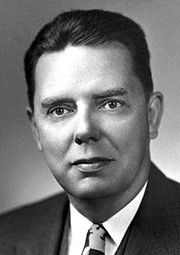Philip Showalter Hench
Philip Showalter Hench | |
|---|---|
 Hench in 1950 | |
| Born | February 28, 1896 |
| Died | March 30, 1965(aged 69) |
| Nationality | American |
| Alma mater | Lafayette College University of Pittsburgh |
| Known for | Discovery ofcortisone |
| Awards | Nobel Prize in Physiology or Medicine(1950) |
| Scientific career | |
| Fields | Medicine |
| Institutions | Mayo Clinic |
| Signature | |
Philip Showalter Hench(February 28, 1896 – March 30, 1965[1]) was an Americanphysician.Hench, along with hisMayo Clinicco-workerEdward Calvin KendallandSwisschemistTadeus Reichsteinwas awarded theNobel Prize for Physiology or Medicinein 1950 for the discovery of the hormonecortisone,and its application for the treatment ofrheumatoid arthritis.The Nobel Committee bestowed the award for the trio's "discoveries relating to the hormones of theadrenal cortex,their structure and biological effects. "[2]
Hench received his undergraduate education atLafayette Collegein Easton,Pennsylvania,and received his medical training at theUnited States Army Medical Corpsand theUniversity of Pittsburgh.He began working atMayo Clinicin 1923, later serving as the head of the Department of Rheumatology. In addition to the Nobel Prize, Hench received many other awards and honors throughout his career. He also had a lifelong interest in the history and discovery ofyellow fever.
Early life[edit]
He attendedLafayette Collegein Easton, Pennsylvania, where he obtained his Bachelor of Arts in 1916. After serving in the Medical Corps of the U.S. Army and the reserve corps to finish his medical training, he was awarded a doctorate in medicine from theUniversity of Pittsburghin 1920. Immediately after finishing his medical degree, Hench spent a year as an intern at St. Francis Hospital in Pittsburgh, and then he subsequently became a Fellow of theMayo Foundation.[3]
In 1928 and 1929, Hench furthered his education atFreiburg Universityand the von Müller Clinic in Munich.[3]
Medical career[edit]
Hench started his career atMayo Clinicin 1923, working in the Department of Rheumatic Diseases. In 1926, he became the head of the department. While at Mayo Clinic, Hench focused his work on arthritic diseases, where his observations led him to hypothesize that steroids alleviated pain associated with the disease.[3]During this same time, biochemistEdward Calvin Kendallhas isolated several steroids from theadrenal glandcortex. After several years of work, the duo decided to try one of these steroids (dubbed Compound E at the time, later to become known ascortisone) on patients afflicted byrheumatoid arthritis.[3]Testing of the hypothesis was delayed because the synthesis of Compound E was costly and time-consuming, and Hench served in the military duringWorld War II.The tests were conducted successfully in 1948 and 1949.[3]

Hench, Kendall, and Swiss chemistTadeus Reichsteinwere awarded the 1950Nobel Prize in Physiology or Medicine"for their discoveries relating to the hormones of the adrenal cortex, their structure and biological effects."[2]As of the 2010 prizes, Hench and Kendall are the only two Nobel laureates affiliated with Mayo Clinic.[4]Hench's Nobel Lecture was directly related to the research he was honored for, and titled "The Reversibility of Certain Rheumatic and Non-Rheumatic Conditions by the Use of Cortisone Or of the Pituitary Adrenocorticotropic Hormone".[5]His speech at the banquet during the award ceremony acknowledged the connections between the study of medicine and chemistry, saying of his co-winners "Perhaps the ratio of one physician to two chemists is symbolic, since medicine is so firmly linked to chemistry by a double bond."[6]
During his career, Hench was one of the founding members of the American Rheumatism Association, and served as its president in 1940 and 1941.[7]In addition to the Nobel Prize, Hench has been awarded the Heberdeen Medal (1942), theLasker Award(1949), thePassano FoundationAward (1950), and theCriss Award.[3]Lafayette College,Washington and Jefferson College,Western Reserve University,theNational University of Irelandand the University of Pittsburgh awarded Hench honorary doctorates.[3]
In addition to his work with cortisone, Hench had a career long interest inyellow fever.Starting in 1937, Hench began to document the history behind the discovery of yellow fever. His collection of documents on this subject are at theUniversity of Virginiain the Philip S. Hench Walter Reed Yellow Fever Collection.[8]His wife donated the collection to the university after his death.[9]
Family[edit]
Hench married Mary Kahler (1905–1982) in 1927.[3]His father-in-law, John Henry Kahler, was a friend of Mayo Clinic founderWilliam J. Mayo.[10]Hench and his wife had four children, two daughters and two sons.[3]His son, Philip Kahler Hench also studied rheumatology.[11]Hench died of pneumonia while on vacation inOcho Rios, Jamaicain 1965.[7]
References[edit]
- ^Philip S. Henchon Nobelprize.org,accessed 2 May 2020
- ^ab"The Nobel Prize in Physiology or Medicine 1950".The Nobel Foundation.Retrieved2011-07-04.
- ^abcdefghi"Philip S. Hench".The Nobel Foundation.Retrieved2011-07-04.
- ^"Nobel Laureates and Research Affiliations".The Nobel Foundation.Retrieved2011-07-04.
- ^"Philip S. Hench".The Nobel Foundation.Retrieved2011-07-04.
- ^"Philip S. Hench - Banquet Speech".The Nobel Foundation.Retrieved2011-07-04.
- ^abSlocumb, C. H. (1965)."Philip Showalter Hench 1896-1965 in memoriam".Arthritis & Rheumatism.8(4): 573–576.doi:10.1002/art.1780080412.PMID14323547.
- ^"The Story".University of Virginia.Retrieved2011-07-04.
- ^"Philip S. Hench".University of Virginia.Retrieved2011-07-04.
- ^"About Kahler".Kahler Hotels. Archived fromthe originalon 2011-06-24.Retrieved2011-07-04.
- ^Copeman, W. S. C. (1965)."Philip S. Hench 1896-1965".Annals of the Rheumatic Diseases.24(3). National Institute of Health: 294.doi:10.1136/ard.24.3.294.PMC1030954.
External links[edit]
- Philip S. Henchon Nobelprize.orgincluding the Nobel Lecture, December 11, 1950The Reversibility of Certain Rheumatic and Non-Rheumatic Conditions by the Use of Cortisone Or of the Pituitary Adrenocorticotropic Hormone
- Biography
- University of Virginia Health Sciences Library, A Guide to the Philip S. Hench Walter Reed Yellow Fever Collection
- 1896 births
- University of Freiburg alumni
- 1965 deaths
- Nobel laureates in Physiology or Medicine
- American Nobel laureates
- American endocrinologists
- Physicians of the Mayo Clinic
- University of Pittsburgh School of Medicine alumni
- United States Army Medical Corps officers
- United States Army personnel of World War I
- United States Army personnel of World War II
- Recipients of the Lasker–DeBakey Clinical Medical Research Award
- Lafayette College alumni
- Deaths from pneumonia in Jamaica
